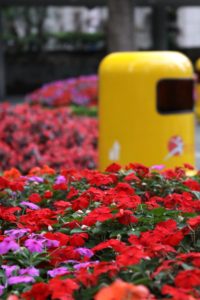 Hong Kong is a bustling city of between 7 and 9 million people (depending on the source you reference. While governed by China, Hong Kong does not require visit visas from citizens of many countries. This is in contrast to mainland China where you will need a visa to enter; the closest mainland entry city to Hong Kong is Shenzhen.
Hong Kong is a bustling city of between 7 and 9 million people (depending on the source you reference. While governed by China, Hong Kong does not require visit visas from citizens of many countries. This is in contrast to mainland China where you will need a visa to enter; the closest mainland entry city to Hong Kong is Shenzhen.
Hong Kong was a dependent territory of the United Kingdom from the early 1840’s until 1997. You may still find some coin currency with the image of Queen Elizabeth II on one side. Today while Hong Kong is a part of China it is mostly self-governed and has its own currency. It is a major business hub for this part of Asia.
This is a city of skyscrapers. In fact out of all the cities in the world Hong Kong has the most skyscrapers. Part of the reason for this is twofold; a huge population coupled with relatively little buildable land as much of the islands are made up of very steep terrain. The tallest building in Hong Kong is the Two International Finance Centre, at 415 m (1,360 ft) which is fairly obvious to see from many vantage points including down by Victoria Harbor and from the top of Victoria Peak.
The Hong Kong Airport is one of the world’s busiest airports and is a hub for this region of Asia with direct flights from Europe, North America and beyond. Wireless Internet is available for free in the airport, albeit it is somewhat slow. Pull up the PCCU network. Visit www.hongkongairport.com for more information.
The Metro connects right to the airport via the “Airport Express” line – the metro is an inexpensive option to reach most of Hong Kong provided you are not carrying lots of luggage. From the airport you will need to purchase a ticket to the Tsing Yi Metro stop. Once you reach this stop you will need to exit through the machines and then purchase another ticket to any metro stops beyond this one. It takes about 10-12 minutes from the airport to the Tsing Yi stop.
Be sure to stop by the official tourism bureau as you make your way through the airport and pick up a Hong Kong Visitor’s Kit. These guides are invaluable and include MTR maps, detailed information about attractions including how to get there as well as containing dining details, shopping information and much more.
Lodging
Budget – some of the cheapest lodging is located near the Mong Kok MTR metro station on Kowloon Island. There are so many budget accommodations in this area that if you don’t have reservations you can walk the side streets inquiring about prices and availability. For reference several basic (small rooms) hostels in the area are in the Sincere Building at 83 Argyle Street. On the 7th floor you have the Dragon Hostel (www.dragonhostel.com). This hostel is very popular with tourists in part due to its excellent Internet visibility on search engines. As a result they are often fully booked and if you know your schedule, it pays to reserve ahead of time by calling or emailing them.
You have the even more basic King Wah Hostel located upstairs on the 10th floor (www.kingwahhostel.com). Note that this building has two elevator entrances of which there are two elevators, one for odd floors and one for even floors. One elevator entrance closes at 11pm while the other is available 24 hours. The King Wah Hostel is run by a very friendly, helpful elderly couple. The man speaks enough English to get by.
Mid range
Dorsett Hotel is located in the heart of Kowloon and is very conveniently located near a plethora of shopping areas as well as within a few minutes walking of the closest metro stop.
Harbor View Hotel as the name indicates is appropriately located in Hong Kong’s business district mere minutes from the big Convention Center. This is a great choice for upscale business travelers. Visit: www.theharbourview.com.hk
High End
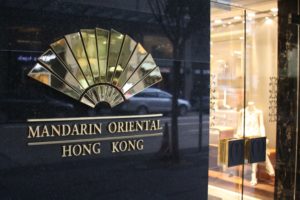 Four Seasons is located the heart of the financial district, on the appropriately titled Finance Road. Visit: www.fourseasons.com/hongkong
Four Seasons is located the heart of the financial district, on the appropriately titled Finance Road. Visit: www.fourseasons.com/hongkong
Mandarin Oriental is also located within the financial district of Hong Kong Island and is surrounded by a plethora of very fancy high end brand name stores. What can you say about the Mandarin chain of hotels other than a stay here is pure luxury. For more information visit: www.mandarinoriental.com/HONGKONG
Transportation
In our experience, the MTR Metro is one of the most well developed metro’s in the world. There are 10 lines offering excellent timely access to most everywhere worth visiting in Hong Kong. We counted four levels at some of the stops. All of the stops are extremely well signed. Note that many of the metro stops have multiple entrances and exits so it is important you know the exit number for your particular destination. For example a Metro may have exits A through E.
Each metro car has several electronic metro maps located near the ceilings above the doors. These are useful because green arrows light up showing you the direction of travel. Before you reach a connecting metro stop, lights for that connecting metro stop will light up showing you all the stops that you can then reach. Additionally exiting at various metro stops differs between the right and left and electronic lights show which side of the car you will exit before you actually reach that stop.
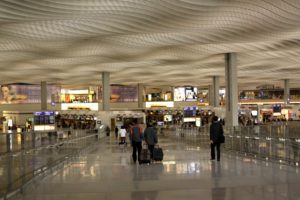 Ticket machines may only accept coins or may accept coins and bills. There is a map associated with each ticket machine and to find the price of the ticket from your current location to your desired location simply touch the metro stop on this map and the price will appear on the screen. Note that if you touch the Airport metro stop no price will appear. This is because you have to touch the closest connecting stop to the airport which is Tsing Yi on the Airport Express Line – and then once you reach that stop, you will have to exit through the turnstyles and then follow the signs to purchase your final ticket to reach the airport.
Ticket machines may only accept coins or may accept coins and bills. There is a map associated with each ticket machine and to find the price of the ticket from your current location to your desired location simply touch the metro stop on this map and the price will appear on the screen. Note that if you touch the Airport metro stop no price will appear. This is because you have to touch the closest connecting stop to the airport which is Tsing Yi on the Airport Express Line – and then once you reach that stop, you will have to exit through the turnstyles and then follow the signs to purchase your final ticket to reach the airport.
If you are going to be using the metro a bunch within a 24 hour time range, consider going to any of the customer service counters and purchasing a 24 hour pass. You cannot buy these from the automatic ticket machines – they must be purchased at these counters. In addition there are also several other bulk purchase pass options.
The Hong Kong metro can be extremely crowded at times and we’ve even seen people denied entry at the busier stops. Once a crowded train exits there may also be waits to get onto the escalators. At the busier stations during peak times trains run more often and waits may not be more than a minute in the best case scenarios.
Be sure to pick up one of the Metro maps at any of the stations. Stations may have their own metro map version which also includes a local map around that particular station as well as local area station attractions. Talk about user friendly! For more information visit: www.mtr.com.hk
Taxis are fairly common in Hong Kong and they all use the meters. The color of the taxi depends on where you are; red taxis are in Hong Kong Island, green are on the New Territories, and blue taxis are found on Lantau Island (Disneyland and the Airport). A typical journey as of press time automatically starts at between 14 and 18 Hong Kong Dollars depending on which taxi you use.
Attractions
We visited the following attractions during our time in Hong Kong.
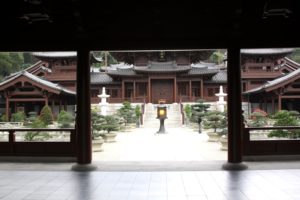 The Chi Lin Nunnery was originally built in the 1930’s but was completely rebuilt in the late 1980’s. It is best accessed by a 5-10 minute walk from the MTR Diamond Hill stop, exit C2. Admission is free. This is an excellent example of hand crafted wood buildings built in a style of the Tang Dynasty. This is a very photogenic location despite being surrounded by tall high rise buildings. If you visit this temple you might as well visit the Nan Lian Garden right across the street (see below for description).
The Chi Lin Nunnery was originally built in the 1930’s but was completely rebuilt in the late 1980’s. It is best accessed by a 5-10 minute walk from the MTR Diamond Hill stop, exit C2. Admission is free. This is an excellent example of hand crafted wood buildings built in a style of the Tang Dynasty. This is a very photogenic location despite being surrounded by tall high rise buildings. If you visit this temple you might as well visit the Nan Lian Garden right across the street (see below for description).
Dr. Sun Yat Museum is located within a 20 minute walk from the Central MTR stop. This museum features the life of Dr. Sun Yat-Sen a revolutionary who figures prominently China’s history. Dr. Sun was educated in Hong Kong (secondary and University education). Several permanent exhibitions are displayed at the museum including information about Hong Kong’s influence on his life. Note that no photos are actually allowed to be taken within the museum. The museum is in the general direction of Victoria’s Peak and therefore can be combined with a visit there.
Man Mo Temple was built in 1847 along Hong Kong’s first road (Hollywood Street) and was built to honor two gods; Man which is the god of literature and Mo the god of war. During the mid 1850’s this area of Hong Kong was the center of the Chinese community and this temple played an important role in their daily lives. The temple is small and free to enter. It is open from 8 to 6pm daily. This temple is located in the heart of Hong Kong’s antique district and there are a number of artists, antiques and other cultural shops in the area. The closest MTR stop is Sheung Wan, exit A2.
Nan Lian Garden is well worth visiting especially when you need some relaxing time “away” from the urban chaos of Hong Kong. This relaxation can be found despite the garden being surrounded by major roads and huge high rise housing complexes that dominates all of urban Hong Kong. This garden attempts to recreate the Tang dynasty period of China (about 600AD to 900AD). Beautiful architecture, serene gardens, water and piped in calming music give this place a peaceful feeling. The garden is laid out in a one way circular route. Take MTR stop Diamond Hill and leave via exit C2. Once you are actually out of the metro turn right and follow the posted signs to the bridge over the road. If you walk straight out of exit C2 you will end up taking the escalator up to the Lung Cheung Mall. A vegetarian restaurant and a gift shop is also located on site.
Ngong Ping Cable Car & Village is accessed from the Tung Chung stop (last stop) on the orange Tung Chung metro line. The entrance to the tram is about a 5 minute walk from the actual outside of the metro stop. On a clear day this is an incredible ride. Nearly 6km in length you ride in a tram car above water and the jagged hillsides. Much of the tram is built very high above the ground or water and as a result you can really see for a long ways (provided the weather is decent). The cheapest way to experience this ride is to buy a one way ticket and take the bus back to the metro stop. Higher prices take affect on weekends and “special” days.
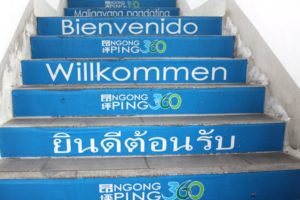 If you take the tram from the terminal at the Tung Chung stop you will arrive on the top of a hill at the Ngong Ping Village which is a collection of souvenir shops, two themed attractions and other informative displays. From the village it is an easy walk to two main attractions; the Po Lin Monastery and the Tian Tan Buddha statue. This statue is reached after climbing up a long flight of steep stairs. It is the world’s tallest outdoor seated bronze Buddha. It is always more interesting to visit the temple when prayer and chantings are being conducted, but even if there is not something going on here, it is still a very unique ornately designed building.
If you take the tram from the terminal at the Tung Chung stop you will arrive on the top of a hill at the Ngong Ping Village which is a collection of souvenir shops, two themed attractions and other informative displays. From the village it is an easy walk to two main attractions; the Po Lin Monastery and the Tian Tan Buddha statue. This statue is reached after climbing up a long flight of steep stairs. It is the world’s tallest outdoor seated bronze Buddha. It is always more interesting to visit the temple when prayer and chantings are being conducted, but even if there is not something going on here, it is still a very unique ornately designed building.
Sik Sik Yuen Wong Tai Sin Temple is a very popular temple located off of the MTR Wong Tai Station, exit B2. The reason this temple is so popular is that it is home to all three of the main religions in China – Buddhism, Taoism and Confucianism. When you are actually outside of the metro be sure to turn right and the actual temple is merely a few minute walk. Faux rocks, waterfalls, and intricate temples make this an interesting visit. As with a number of temples we have visited in Hong Kong this one is also almost completely surrounded by huge tall housing complexes and other urban buildings.
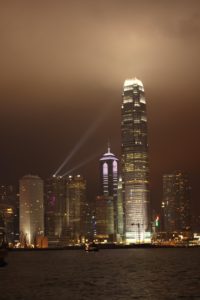 The Symphony of Lights is a must visit free attraction that involves more than 40 buildings on both sides of Victoria Harbor (buildings on Kowloon as well as Hong Kong Island). The tallest building in Hong Kong, the Two International Finance Centre, at 415 m (1,360 ft) also plays a role in this light show. According to the Guinness book of world records, it is the world’s Largest Permanent Light and Sound Show”. There are excellent views from the waterfront near the Golden Bauhinia Square. Take MTR Wan Chai Station Exit A5 and for the most part walk under a covered walkway that leads from the huge convention center. This walkway is well signed and it will take about 15-20 minutes from exiting the metro stop to reaching the waterfront. The Symphony of Lights starts promptly every night at 8pm and only lasts about 15 minutes. If you arrive early you will probably see a line of people waiting to get onto the harbor front boats as from these boats you have the best views of the light show. During the event several buildings change colors and huge spotlights beam from the top of other buildings also with changing colors.
The Symphony of Lights is a must visit free attraction that involves more than 40 buildings on both sides of Victoria Harbor (buildings on Kowloon as well as Hong Kong Island). The tallest building in Hong Kong, the Two International Finance Centre, at 415 m (1,360 ft) also plays a role in this light show. According to the Guinness book of world records, it is the world’s Largest Permanent Light and Sound Show”. There are excellent views from the waterfront near the Golden Bauhinia Square. Take MTR Wan Chai Station Exit A5 and for the most part walk under a covered walkway that leads from the huge convention center. This walkway is well signed and it will take about 15-20 minutes from exiting the metro stop to reaching the waterfront. The Symphony of Lights starts promptly every night at 8pm and only lasts about 15 minutes. If you arrive early you will probably see a line of people waiting to get onto the harbor front boats as from these boats you have the best views of the light show. During the event several buildings change colors and huge spotlights beam from the top of other buildings also with changing colors.
Victoria Peak & tram is a one of the better places to come to get a very good overview of Hong Kong and its surrounding environs. You can hire a taxi to take you here or you can take the very steep tram that runs regularly up and down the mountain every 10 to 15 minutes. The closest Metro stop is Central (exit J2). Expect to walk at least 15-20 minutes to the lower tram station.
The Peak Galleria and the Peak Tower Sky (the unique half circle on its side building) are both located on top near the tram and are home to many shops. Both locations have viewing terraces although you will have to pay to go up to the Tower Sky Terrace (be sure to buy your tickets for this on the first floor as you cannot purchase them at the tower entrance on the top floor). However there are plenty of excellent views looking down on the city from near the Peak Tower Sky and there is a road/path that winds around the hillside. Visit: www.thepeak.com.hk
Mid-Levels Escalator is the World’s Longest Covered Escalator and is approximately 2600 feet long (800 meters) or half a mile in length. It is raised above the street level. This escalator is actually split up into multiple sections; one section ends and you walk a short distance to the next one. The direction of the escalator depends on the time of day. It flows downhill from 6am until 10am and then uphill from approximately 10:20am until midnight. It is a 5 minute walk to this escalator from the Central MTR stop, exit D1.
Shopping
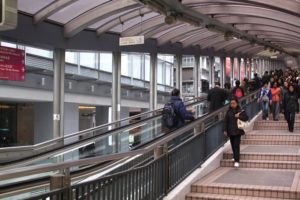 Hong Kong is a major player in the International shopping scene. You will not find a shortage of shopping here and the limiting factors of course are time and money. Shopping is available for all budgets ranging from the cheap street markets near the Mong Kok area in Kowloon to the very expensive International fancy name brand stores on Hong Kong Island. Take the Central stop on the MTR blue Island Line to reach these luxury shops.
Hong Kong is a major player in the International shopping scene. You will not find a shortage of shopping here and the limiting factors of course are time and money. Shopping is available for all budgets ranging from the cheap street markets near the Mong Kok area in Kowloon to the very expensive International fancy name brand stores on Hong Kong Island. Take the Central stop on the MTR blue Island Line to reach these luxury shops.
For indoor shopping communities, there are many fairly large malls in Hong Kong as well. A couple that we visited and can recommend are The Peak Mall on Victoria Peak (the very unique shaped building), the Shun Tak Center next to the main Ferry Terminal.
Electronics. Hong Kong is certainly the place to find electronics some of which may be cheaper than the USA. The Apliu Street Flea Market near the Sham Shui Po MTR stop (exit C2) has a great selection of various electronics and computer supplies. This is on Kowloon Island off of the red MTR line (Tsuen Wan Line). Think Newegg.com in real life as there are tons of small vendors selling the latest and not so latest computer and other electronic gadgets. Bargain for anything.
The area along Hollywood Street near the Man Mo Temple is a great place to shop for antiques and other art works. However bring your bargaining hat whenever shopping in these places especially for the more expensive items. We walked into one of the stores inquiring about a silkscreen piece. We were quoted a price of $1100 and 3 minutes later the price was down to $500 with the final offer to contact the artist to see about getting us an even lower price!
The Plaza Hollywood Mall is located right next to the MTR Diamond Hill Stop, Exit C2 and walk straight to the escalator upon leaving the metro. This is one of the largest shopping malls on Kowloon Island. It was designed by an American. Visit: www.plazahollywood.com.hk
The Lung Cheung Mall is located right next to the MTR Wong Tai Sin Station, Exit B2.
Food
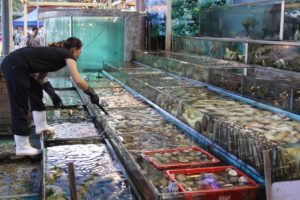 Street food can be found in certain areas of Hong Kong but its definitely not as plentiful as say the streets of Bangkok. Hong Kong is well known for its high quality of Dim Sum. If you go to the more local dim sum places chances are you will be the only “tourist” in the restaurant. The menus will certainly only be in Chinese and if you do not speak the language you may find yourself pointing to other dishes that other people have ordered. Most of the Dim Sum restaurants do not deliver food on a cart, rather you have to order from a menu.
Street food can be found in certain areas of Hong Kong but its definitely not as plentiful as say the streets of Bangkok. Hong Kong is well known for its high quality of Dim Sum. If you go to the more local dim sum places chances are you will be the only “tourist” in the restaurant. The menus will certainly only be in Chinese and if you do not speak the language you may find yourself pointing to other dishes that other people have ordered. Most of the Dim Sum restaurants do not deliver food on a cart, rather you have to order from a menu.
A couple of good restaurants are the following:
The very small Se Wong Ye serves up authentic snake soups and is located at 24 Percival Street in Causeway Bay. This is a locals favorite and is always crowded.
Sevva Restaurant is located on the rooftop of the Prince Building (25th floor), 10 Chater Road. Incidentally outside on the terrace is a great place to watch the Symphony of lights at night and they make some killer “Hong Kong” cocktails.
Money
ATM’s are readily available in the city. In addition there are a plethora of permanent money changers who will change common currencies into Hong Kong dollars.
The United Kingdom gave up Hong Kong in 1997 and with it the money also changed in appearance although you may still find coins with Queen Elizabeth the 2nd’s image on them.
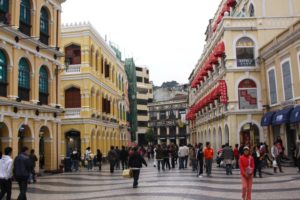 Macau can make a fast day trip from Hong Kong and is certainly a destination in its own right. While you can visit Macau in a day from Hong Kong it is recommended to stay at least a few days, especially if you enjoy casinos. From Hong Kong it is about an hour away via high speed ferry or via Helicopter it takes approximately 16 minutes. Both the ferries and the helicopter leave from the Ferry Terminal on Hong Kong Island. This terminal is located within about a 10 minute walk from the Sheung Wan MTR metro stop which is the last stop on the blue Island MTR Line. Note that you can also catch a ferry to Macau from Hong Kong’s International airport.
Macau can make a fast day trip from Hong Kong and is certainly a destination in its own right. While you can visit Macau in a day from Hong Kong it is recommended to stay at least a few days, especially if you enjoy casinos. From Hong Kong it is about an hour away via high speed ferry or via Helicopter it takes approximately 16 minutes. Both the ferries and the helicopter leave from the Ferry Terminal on Hong Kong Island. This terminal is located within about a 10 minute walk from the Sheung Wan MTR metro stop which is the last stop on the blue Island MTR Line. Note that you can also catch a ferry to Macau from Hong Kong’s International airport.
Also note that you need your passport to go through immigration as at the terminal you will go through customs to receive your departure stamp from Hong Kong. You will be given a immigration card on the ferry to fill out for Macau where you will go through customs again once you reach the Macau Ferry Terminal. Note that in our experience the lines move fairly fast for both immigration locations in both directions.
Typically both Hong Kong dollars and the Macau Pataca (unit of currency) are accepted on the island although you may find certain slot machines in the casinos only accept one or the other denomination. As of press time the Pataca and the HKD are very similar to each other in regards to the exchange rate.
There are a number of attractions on Macau – with the most obvious being the large casinos. These tower near the waterfront and form the “first layer” of modern day Macau. International standbys are found here including the Wynn and MGM. As in Vegas the Wynn Casino has built the Wynn Casino and then added the Wynn Encore. Both these buildings look very similar to the Wynn buildings in Las Vegas, USA. If you are after hard core International name brand shopping, look no further than the Wynn Casino. Visit: www.wynnmacau.com
 Delve a bit deeper into Macau by getting out of the casino strip area and you find a lot of history. Macau was controlled by Portugal for 400+ years and they have certainly left their mark on the island. Signs are still in Portuguese and there are a number of colonial European looking buildings in the old town. The old town is a great place for walking.
Delve a bit deeper into Macau by getting out of the casino strip area and you find a lot of history. Macau was controlled by Portugal for 400+ years and they have certainly left their mark on the island. Signs are still in Portuguese and there are a number of colonial European looking buildings in the old town. The old town is a great place for walking.
Macau Tower is among the tallest of the world’s “space towers”; it stands 338 meters. This is also home to the tallest bungee jump in the world. For those less adventurous a “sky walk” is also offered in which you are tethered to the building as you walk around outside of the top of the tower while leaning over to look down 61 stories below. A tower ticket allows you access to 2 floors, #58 and #61. The 58th floor is enclosed and is surrounded by windows for a 360 degree view of the city. In addition windows are built into part of the floor allowing one a dizzying view of the streets far below. The 61st floor is somewhat open air. At the bottom you can also buy a ticket for a buffet meal at the top. Visit: www.macautower.com.mo
Wine & Grand Prix Museum – these two museums are located in the same building right next to each other. The wine museum concentrates on Portuguese varietals and Portugese wine. It is a small museum with exhibits that take you through the history of wine and as well as the main wine regions in Portugal. A highlight is a tasting (all Portugal produced wines of course!). The Grand Prix museum details the history of the Grand Prix in Macau as well contains a fine display of historical racing automobiles.
Useful Links
Hong Kong tourism bureau – www.discoverhongkong.com and Macau tourism bureau – www.macautourism.gov.mo
More Photographs
- Hong Kong
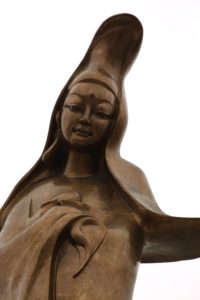
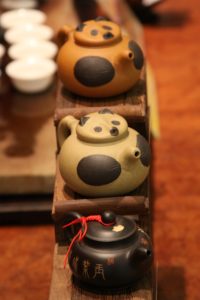
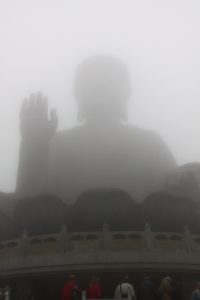
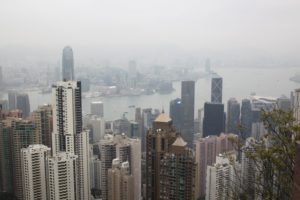
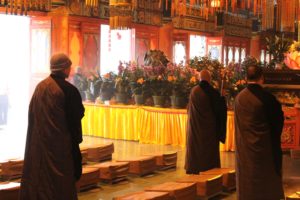
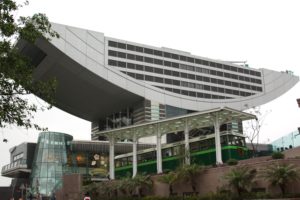
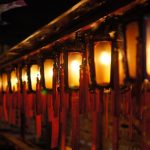
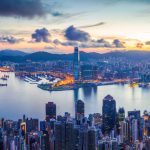
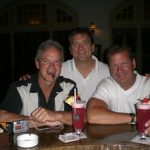
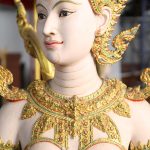
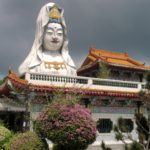
Nice write-up. Don’t forget the Tai O fishing village for a taste of old school Hong Kong. You can comfortably wander around this little town and fisherman and other vendors will hawk their wares, and not treat you like a tourist in the process. Its worth a visit when you get tired of the concrete in the city.
Thanks for the tip. I fly into HKG every once in a while when I am visiting various parts of Asia – I’ll be sure to check out Tai O fishing village. I love fresh seafood.